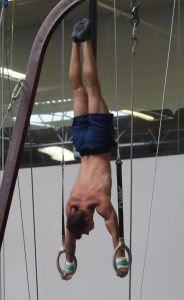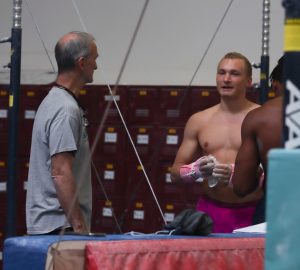- Slug: Sports-Barclay ASU Gymnastics, 1,200 words.
- 3 photos available (thumbnails, captions below).
By Keion Cage
Cronkite News
CHANDLER – From teaching preschoolers how to flip in a 3,000-square-foot room to owning a 32,000-square-foot multi-purpose gymnastics facility in Chandler, Scott Barclay has dedicated his career to keeping the sport he loves tied to Arizona State.
But the road over the past three decades wasn’t always a straight path for the ASU men’s gymnastics coach and Aspire Kids Sports Center founder.
In May 1993, Barclay and the ASU men’s gymnastics coaching staff received notice that ASU would demote the team from its Division I status, which ended school funding for the program. For a moment, the ASU men’s gymnastics program was on the verge of extinction.
“The athletic director pulled us down and had a big team meeting … [to tell us coaches that] we’re canceling the program. We don’t have enough money,” Barclay said. “Our hearts just all sank. And it was in the middle of season, too. We had to finish the season knowing that we wouldn’t have a team next year. It was devastating.”
Barclay’s leadership and determination, however, would keep the program alive.
Today, while men’s gymnastics remains a non-Division I program, the Sun Devils have evolved into a fully self-funded club team. Over time, the team has found effective ways to fundraise and secure the future of ASU men’s gymnastics through booster club memberships and donations, corporate sponsorships and team fundraising. Barclay’s coaching staff and gymnasts also host junior meets and clinics, assemble equipment for local junior competitions, build competition floors for local gyms and score junior competitions to generate over 60% of the funds needed to compete.
Each year, the goal is to raise an estimated $225,000, which covers travel and allows the Sun Devils to participate in their men’s gymnastics club league, GymACT. But in the beginning, hitting that figure presented challenges.
Shortly after ASU cut the team’s funding, Barclay registered the team as a sports club team under the ASU Recreation Department in hopes the school would reverse its decision and return the program to its Division I status before the following season.
But ASU didn’t.
“Obviously, I felt terrible about it,” Barclay said. “[The head coach at the time] volunteered to stay on coaching if [ASU] kept the program as a club. I did the same thing, because I felt obligated to the guys on the team that I recruited. I falsely recruited them under the impression that [the school] wouldn’t drop the sport that year.”
During the club’s first year, the program relied on donations, personal funds and free services. The Sun Devils finished in first place in its inaugural season as a club team in the 1994 USA Collegiate Club National Championships and showed it can still be a successful program without school funding.
“We hold [the program’s history] highly on our team,” ASU rising senior and gymnast Clayton Cunningham said. “So, we always know where we come from.”
Barclay, who was inducted into the ASU Hall of Fame in 1999, always found himself around gymnastics. Before becoming the ASU men’s gymnastics coach, Barclay was a Sun Devil gymnast and a member of the USA National Team in the early 1970s. He helped the Sun Devils place second in the 1978 NCAA Nationals and became an All-American.
In his first year as an assistant coach under former ASU men’s gymnastics coach Don Robinson, the team won the NCAA title in 1986. He initially committed to coaching for only one more year after the team’s funding was cut in 1993, or so he thought.
“l told them, ‘I’ll stay one more year and I’ll train you guys to keep you in shape,’” Barclay said. “We’ll do whatever we need to do to get you until you can matriculate out to go to another school. So there were a couple of guys that did move on to other schools, but the majority of them all stayed … but then more kids came [to be a part of the team]. I didn’t recruit them. They just showed up. The [following] year, a couple more kids came. Now, here you have a program.”
For Barclay, that one year turned into 30 years with the program. The Sun Devils have won 25 national titles, which includes a run of 14 straight. On May 13, the team added to its haul by taking home the GymACT title. From working to help with team funding to taking out a $3 million loan to build a multi-purpose facility for his athletes to practice, Barclay did everything he could to keep the men’s gymnastics going at ASU.
“Anything great comes with sacrifice, anything worth anything costs something,” Barclay said. “I think this program has a lot of value because a lot of people sacrificed for it … I just have a great admiration for the guys that want to keep trying to do it when it gets so hard. And I think my role as a coach is to encourage them to keep going and find a way to do it.”
Barclay’s passion for gymnastics has not only impacted the ASU men’s gymnastics team but the local community as well. Through Barclay’s facility, Aspire Kids Sports Center, he hosts camps and after-school programs for children to learn gymnastics, dance, swim and martial arts.
Weekly, hundreds of kids can be seen flipping on gymnastic mats and jumping on the trampoline while the ASU men’s gymnastics team trains for competitions in the background.
“I never envisioned this right at the very beginning, but it evolved to something,” Barclay said. “In five years from now, I hope people look back and go, ‘It was well worth the fight,’” because there’s some things in life that are worth fighting for.”
Hard work and sacrifice are the words that Barclay used to describe how he built a facility that hosts hundreds of children on a daily basis and managed to keep the ASU men’s gymnastics program growing. But to his athletes and supporters, it was his love for the sport and care for young athletes that made the ASU men’s gymnastics program what it is today, even if it’s still not considered a Division I program.
“[Barclay] still had this dream and goal of getting it back to the university one day. That’s kind of what started this whole venture for him,” Cunningham said. “It’s been so crazy just to see one movement of him being like, ‘I want to keep it alive and keep the team alive’ … turned into a whole business for him to help take care of us.”
For more stories from Cronkite News, visit cronkitenews.azpbs.org.


